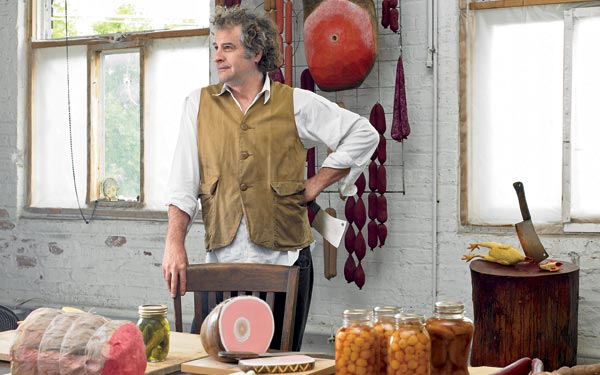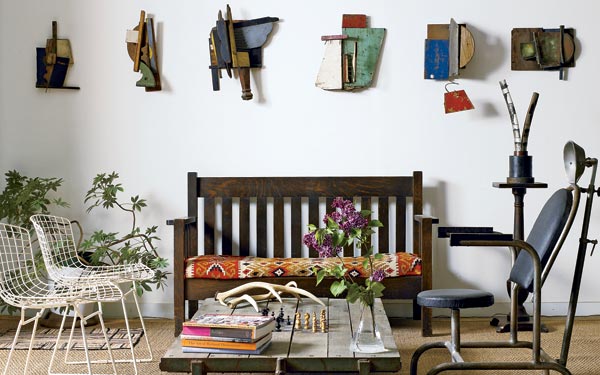|
|
The space: Artist Michael Thompson’s Garfield Park loft (michaelthompsonart.com). The vibe: Real-deal bohemian: short on furniture, long on art and collections. The stuff: Thompson is the first to admit that "there’s a lot of jazz" in his studio. His artwork—including large-scale paper-and-bamboo kites (sold at Pagoda Red; two appeared in The Dark Knight, the recent Batman movie); chunky, reclaimed-wood sculptures; prints; collages; and kinetic sculptures made from Erector Sets—cover walls and fill shelves to capacity (additional work is tucked away in portfolios and flat files). A combination etching/litho press, which he bought while studying fine art at the School of the Art Institute in the ’80s, occupies one corner of the large room. "I figured for the same money, I could either buy this press or finish school; I bought the press, and ever since, I’ve been trying to prove that I could have graduated from art school if I wanted to," he jokes. His claim to fame: About half of one long wall in Thompson’s studio is devoted to his famous (and, in some circles, infamous) stamp art. Since the ’90s, he has been producing sheets of counterfeit postage stamps (at first using a copy machine and later, computers), copying the designs and typefaces of official stamps from around the world and using his own—usually politically charged, humorous, or erotic—images to illustrate them. A "Spanish" stamp celebrates an anniversary of the Spanish Inquisition; a "Chinese" one features a sole man standing in front of a tank in Tiananmen Square. He mails letters from around the world using these miniature works of art as postage, sending them to friends, who then return the envelopes to him so he can create his pieces (usually composed of a sheet’s worth of any given stamp and one or more letters posted with it). Morlen Sinoway, who sells Thompson’s work at his West Loop gallery, gets the majority of the letters; hundreds more have been confiscated by mail workers around the world over the years. Not surprisingly, the U.S. Postmaster General is not a fan.
Photography: Kate Roth
Related:
|
|
His furniture: Two thousand square feet affords Thompson enough space for four six-foot antique tables ("I like to spread out"). His sofa is a rather uncomfortable-looking bench ("I like to think it’s a Stickley, but I don’t think it actually is") that he found in Massachusetts some 30 years ago. His coffee table is an old warehouse cart on which he drew a chessboard, and one of his side chairs is an old dental chair that Deborah Colman, co-owner of Pavilion, in Bucktown, traded him for one of his stamp pieces. The collector: Since much of his work involves assemblage, be it three-dimensional (such as his "Cornell boxes," vessels filled with small items in the style of the famously reclusive artist Joseph Cornell) or on paper, Thompson must constantly have a large supply of ephemera at his disposal. He frequents thrift stores, flea markets, and Dumpsters and picks up scraps of paper in the street for his stash. But he isn’t just collecting junk. He studies auction catalogs and books about ancient civilizations, and thus often knows the value of what he finds. He recently came across a Spatterware plate (highly collectible 19th-century American and English pottery with sponged or spattered patterns on it) for $14 at the Chicago Antique Market. Tossed on a tabletop is an article torn from The New York Times about a cache of museum-quality ancient cylinder seals that had been plundered after the invasion of Iraq and that was recently returned to its government—Thompson picked up a few similar, eraser-sized cylinders (made of agate and etched with primitive images) at a flea market in Turkey years ago. He likes to "keep things that have intrinsic value, and not sell them." Currently working on: A sculpture ("a horizontal tornado" made of aluminum disks that Thompson coated with copper powder and oxidized to a pretty sea-foam green) for shop owner/interior designer Michael Del Piero, and a "Suicide Barbie" inspired by female suicide bombers. "It’s got to be entertaining," the artist says, "or it’s not worth it."
Photography: Kate Roth
Related:




